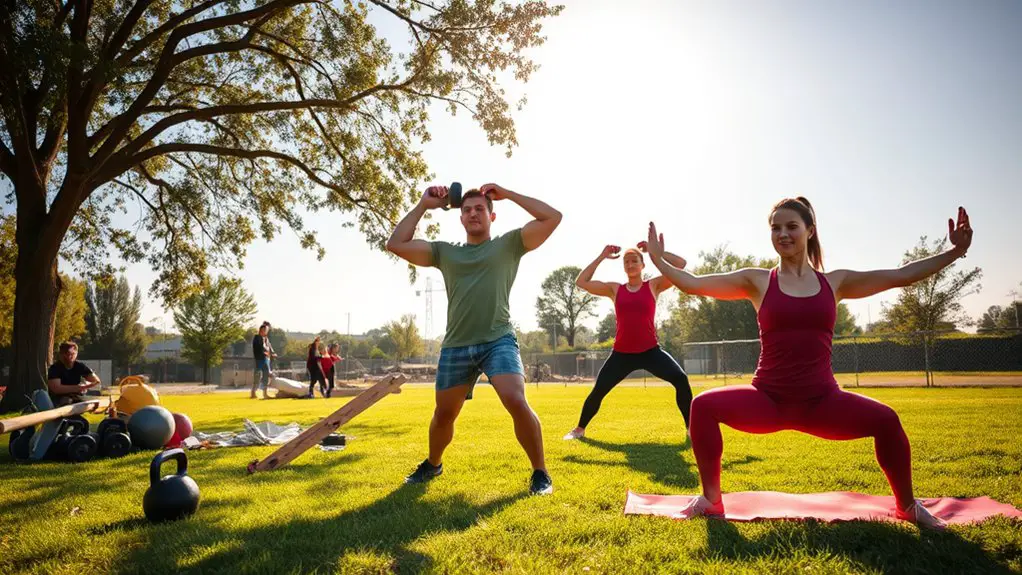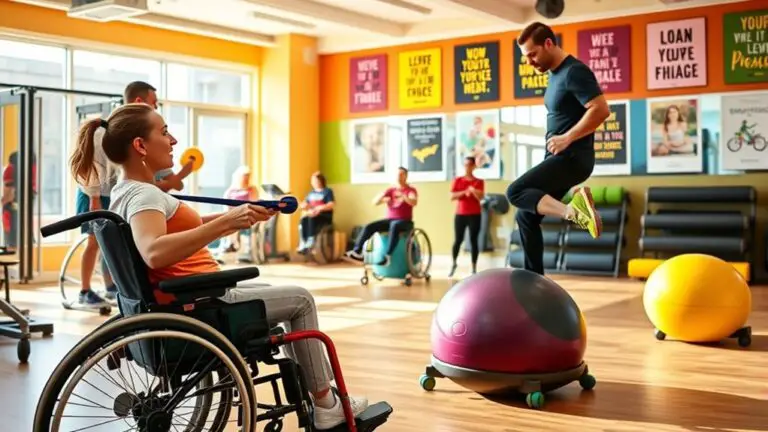How to Train for Physical Labor Jobs Without Overtraining

To train for physical labor jobs without overtraining, start by understanding your job’s unique demands and set realistic fitness goals. Incorporate a balanced regimen of strength and endurance training, focusing on compound movements and allowing for recovery days. Pay attention to your nutrition, emphasizing protein and hydration to support your body. Don’t ignore signs of overtraining like fatigue or mood changes. With these strategies, you’re on track to build the resilience needed for your role, and there’s more to explore.
Understanding the Demands of Physical Labor Jobs

When you consider a career in physical labor, it’s essential to understand the unique demands these jobs place on your body and mind. Physical demands often include lifting heavy objects, standing for long periods, and performing repetitive tasks, all of which can lead to fatigue or injury if you’re not adequately prepared. Job requirements typically vary by industry, ranging from construction and warehouse work to agriculture and landscaping.
You’ll need to develop strength, endurance, and flexibility to meet these challenges head-on. Additionally, mental resilience is vital, as physical labor can be mentally taxing, requiring focus and determination. Understanding these aspects will help you gauge whether you’re suited for such roles and what training you may need. Preparing your body and mind for these physical and psychological demands will ultimately set you up for success in your chosen career path.
Setting Realistic Fitness Goals
Setting realistic fitness goals is essential for anyone preparing for the demands of physical labor jobs, as it helps maintain motivation and guarantees progress. Start by evaluating your current fitness level to set achievable targets. Establish realistic expectations based on your strengths and areas for improvement. For instance, if you’re new to strength training, aim to increase your lifting capacity gradually rather than trying to lift heavy weights right away.
Incorporate goal tracking into your routine. This can be done through daily logs or fitness apps, helping you visualize your progress over time. Break larger goals into smaller, manageable milestones to celebrate accomplishments along the way. Don’t forget to adjust your goals as you improve; flexibility is key. Remember, the journey is just as important as the destination, so stay focused on your progress and keep pushing forward. Setting realistic goals will not only enhance your performance but also boost your confidence. Additionally, pay attention to signs of progress such as increased strength and improved energy levels, which can further motivate your training efforts.
Designing a Balanced Training Regimen

To effectively prepare for the physical demands of labor-intensive jobs, it’s essential to design a balanced training regimen that incorporates strength, endurance, flexibility, and mobility. Start by determining your training frequency; aim for at least four to five sessions per week. This consistency helps build a solid foundation.
Incorporate exercise variation by mixing different activities like weightlifting, running, yoga, and stretching. This not only keeps your workouts engaging but also targets various muscle groups, reducing the risk of overuse injuries. For strength, focus on compound movements that replicate the actions you’ll perform on the job.
Don’t forget to include flexibility and mobility exercises to enhance your range of motion, which is vital for preventing injuries. By maintaining a balanced approach with consistent training frequency and diverse exercise variation, you’ll be well-prepared for the demands of physical labor jobs while minimizing the risk of overtraining.
Incorporating Strength and Endurance Training
To excel in physical labor jobs, you need to focus on both strength and endurance training. Understanding the basics of strength training, exploring effective endurance techniques, and balancing these workouts will help you build the necessary stamina and power. Let’s break down how to incorporate these elements into your training routine.
Strength Training Basics
While many people associate strength training solely with building muscle, it’s essential to recognize that incorporating endurance training can greatly enhance your performance in physical labor jobs. Understanding weightlifting fundamentals is vital for effective training. Here are some key strength training techniques to take into account:
- Compound Exercises: Focus on movements like squats and deadlifts that work multiple muscle groups.
- Progressive Overload: Gradually increase weights or resistance to challenge your muscles.
- Form and Technique: Prioritize proper form to prevent injury and maximize efficiency.
- Rest and Recovery: Allow adequate recovery time between sessions to promote muscle growth and avoid overtraining.
Endurance Training Techniques
Incorporating endurance training into your routine is essential for excelling in physical labor jobs, as it enhances stamina and allows you to sustain energy levels throughout long shifts. Focus on incorporating endurance intervals into your workouts, alternating between high-intensity efforts and recovery periods. This method not only improves your aerobic capacity but also builds resilience against fatigue. For example, you might sprint for 30 seconds followed by a minute of walking, repeating this for 15-20 minutes. Additionally, consider activities like cycling or swimming, which can further enhance your endurance while being low-impact on your joints. By blending these techniques with your strength training, you’ll create a balanced program that prepares you for the demands of your job without risking overtraining.
Balancing Workouts Effectively
Balancing strength and endurance training is key to preparing for the physical demands of labor-intensive jobs. To achieve this, consider the following strategies:
- Workout Frequency: Aim for at least 4-5 workout sessions per week to build both strength and endurance effectively.
- Exercise Variety: Incorporate different types of exercises, such as weightlifting, running, and bodyweight workouts, to target multiple muscle groups.
- Split Training: Alternate between strength and endurance days to allow muscle recovery while maintaining an active schedule.
- Monitor Progress: Keep track of your performance and adjust your routine as necessary to avoid plateaus and overtraining.
The Importance of Recovery and Rest Days
Although you might feel tempted to push through fatigue and skip rest days, understanding the importance of recovery is essential for anyone training for physical labor jobs. Incorporating rest days into your routine allows your body to repair and strengthen itself, reducing the risk of injury. Active recovery, such as light stretching or leisurely walking, keeps your blood flowing while allowing your muscles to recover without complete inactivity.
Moreover, mental recovery is just as vital; taking time off helps prevent burnout and keeps your motivation high. Engaging in hobbies or simply relaxing can recharge your mind, making you more focused and efficient when you return to training. Remember, consistent progress isn’t just about hard work; it’s about balancing effort with adequate recovery. Prioritizing rest will enhance your overall performance, making you more resilient and prepared for the demands of physical labor jobs.
Nutrition for Optimal Performance

When it comes to training for physical labor jobs, what you eat can greatly impact your performance and recovery. To maximize your strength and endurance, focus on achieving a good macronutrient balance and effective hydration strategies. Here are some key points to reflect upon:
- Protein: Aim for lean sources like chicken, fish, and legumes to support muscle repair.
- Carbohydrates: Incorporate whole grains, fruits, and vegetables for sustained energy.
- Fats: Include healthy fats, such as avocados and nuts, to fuel your body.
- Hydration: Drink water consistently throughout the day, and reflect upon electrolyte-rich drinks during intense work.
Listening to Your Body: Recognizing Signs of Overtraining
As you push your limits in training for physical labor jobs, it’s essential to listen to your body. Common signs of overtraining, like persistent fatigue and decreased performance, can signal that you need to take a step back. Prioritizing recovery time not only helps prevent injury but also enhances your overall strength and endurance.
Common Overtraining Symptoms
How can you tell if you’re pushing your body too hard in your training for physical labor jobs? Recognizing overtraining signs is essential to avoid burnout and injuries. Here are some common symptoms you should watch for:
- Persistent Fatigue: You feel drained, even after rest days.
- Decreased Performance: Your strength or endurance is slipping despite consistent training.
- Mood Changes: You’re experiencing irritability or mood swings that weren’t there before.
- Sleep Disturbances: You’re having trouble falling asleep or staying asleep.
If you notice these signs, it’s time to implement recovery strategies like adjusting your training schedule, incorporating rest days, or focusing on nutrition. Listening to your body can help you stay on track and perform your best.
Importance of Recovery Time
Although many people push through discomfort to achieve their fitness goals, recognizing the importance of recovery time is essential for long-term success, especially in physically demanding jobs. Your body needs time to repair and rebuild after intense workouts, which is where effective recovery techniques come into play. Prioritize rest days, and don’t underestimate the power of sleep; it’s vital for physical and mental recovery. Listen to your body—if you’re feeling fatigued or irritable, it’s a sign you might need more downtime. Incorporating activities like stretching, foam rolling, or even light yoga can aid recovery. Remember, taking time to recover isn’t a setback; it’s an investment in your endurance and overall performance in your physically demanding job.
Benefits of Cross-Training for Physical Labor Preparedness

Cross-training offers a dynamic approach to preparing for physical labor jobs, enhancing overall fitness and resilience. By diversifying your training routine, you can maximize cross-training benefits and minimize the risk of injury. Here are four key advantages:
- Improved Strength: Engaging in various exercises targets different muscle groups, building balanced strength.
- Enhanced Endurance: Mixing cardio and strength training boosts your stamina, vital for demanding physical tasks.
- Injury Prevention: Cross-training reduces repetitive strain on specific muscles, lowering your chances of overuse injuries.
- Mental Engagement: Variety keeps your workouts interesting, increasing motivation and adherence to your training program.
Incorporating cross-training into your regimen not only prepares you for the physical demands of labor jobs but also fosters a more resilient body. Embrace this versatile training method, and you’ll be ready to tackle any challenge that comes your way.
Frequently Asked Questions
What Are Some Common Injuries in Physical Labor Jobs?
In physical labor jobs, you’re likely to encounter common injuries like back injuries and repetitive strain. Back injuries often result from heavy lifting or awkward movements, leading to chronic pain or disability. Repetitive strain injuries occur from performing the same motion repeatedly, affecting your muscles, tendons, and nerves. It’s essential to recognize these risks and implement preventive measures, such as proper lifting techniques and taking breaks, to keep yourself safe and healthy on the job.
How Can I Improve My Flexibility for Physical Labor?
To improve your flexibility for physical labor, incorporate dynamic stretching into your routine. This involves moving parts of your body through a full range of motion, which helps prepare your muscles for work. Additionally, don’t underestimate the benefits of foam rolling; it can release tight muscles and improve blood flow. Aim for a combination of these techniques before and after your workouts, and you’ll notice increased flexibility and reduced injury risk.
What Should I Wear for Training to Prevent Injuries?
If you think wearing flip-flops for training is a smart choice, you might be in for a surprise! For proper training, invest in quality training footwear that provides support and stability. Don’t forget protective gear like knee pads and gloves—they’re not just for show! Make certain your clothing allows for movement, like moisture-wicking materials. Dressing appropriately will keep you safe and comfortable, making your training more effective and enjoyable.
How Often Should I Reassess My Fitness Goals?
You should reassess your fitness goals every 4 to 6 weeks. This timeframe allows you to evaluate your progress and adjust your goal setting as needed. By tracking your progress regularly, you’ll identify what’s working and what isn’t. If you’re hitting your targets, you might want to aim higher; if not, consider modifying your approach. Remember, staying adaptable is key to maintaining motivation and achieving long-term success in your training.
Can I Train for Physical Labor While Recovering From an Injury?
Yes, you can train for physical labor while recovering from an injury, but you need to be careful. Focus on rehabilitation exercises that promote healing and strength without aggravating your injury. Incorporate modified workouts that adapt to your current abilities, ensuring you don’t push too hard too soon. Pay attention to your body’s signals, and consider consulting a professional to tailor your routine effectively. It’s important to balance recovery and preparation.





